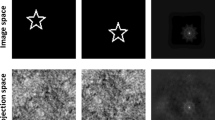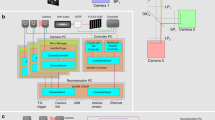Abstract
We introduce an imaging modality that, by offsetting pixel-exposure times during capture of a single image frame, embeds temporal information in each frame. This allows simultaneous acquisition of full-resolution images at native detector frame rates and high-speed image sequences at reduced resolution, without increasing bandwidth requirements. We demonstrate this method using macroscopic and microscopic examples, including imaging calcium transients in heart cells at 250 Hz using a 10-Hz megapixel camera.
This is a preview of subscription content, access via your institution
Access options
Subscribe to this journal
Receive 12 print issues and online access
$259.00 per year
only $21.58 per issue
Buy this article
- Purchase on Springer Link
- Instant access to full article PDF
Prices may be subject to local taxes which are calculated during checkout


Similar content being viewed by others
References
Kner, P., Chhun, B.B., Griffis, E.R., Winoto, L. & Gustafsson, M.G.L. Nat. Methods 6, 339–342 (2009).
Hanley, Q.S., Verveer, P.J., Gemkow, M.J., Arndt-Jovin, D. & Jovin, T.M. J. Microsc. 196, 317–331 (1999).
Nayar, S.K., Branzoi, V. & Boult, T.E. Int. J. Comput. Vis. 70, 7–22 (2006).
Takhar, D. et al. Computational Imaging IV 6065, 43–52 (2006).
Hoefling, R. Proc. SPIE 5303, 1117/12.528341 (2004).
Efimov, I.R., Nikolski, V.P. & Salama, G. Circ. Res. 95, 21–33 (2004).
Spors, H., Wachowiak, M., Cohen, L.B. & Friedrich, R.W. J. Neurosci. 26, 1247–1259 (2006).
Denvir, D. & Conroy, E. Proc. SPIE 4796, 164–174 (2003).
Entcheva, E. & Bien, H. Prog. Biophys. Mol. Biol. 92, 232–257 (2006).
Tallini, Y.N. et al. Proc. Natl. Acad. Sci. USA 103, 4753–4758 (2006).
Tominaga, T., Tominaga, Y., Yamada, H., Matsumoto, G. & Ichikawa, M. J. Neurosci. Methods 102, 11–23 (2000).
Levoy, M., Zhang, Z. & McDowall, I. J. Microsc. 235, 144–162 (2009).
Veeraraghavan, A., Raskar, R., Agrawal, A., Mohan, A. & Tumblin, J. ACM Trans. Graph. 26, 69:1–69:12 (2007).
Agrawal, A. & Raskar, R. Proc. IEEE Comput. Soc. Conf. Comput. Vis. Pattern Recognit. 2007, 1–8 (2007).
Wilburn, B., Joshi, N., Vaish, V., Levoy, M. & Horowitz, M. Proc. CVPR 2004, 294–301 (2004).
Yamamoto, T. et al. J. Physiol. (Lond.) 562, 455–475 (2005).
Hofling, R. & Ahl, E. Proc. SPIE 2004, 322–329 (2004).
Acknowledgements
We thank P. Cobden and R. Vaughan-Jones for providing isolated cells, A. Garny for help with editing, and Oxford University's Isis Innovation, the UK Biotechnology and Biological Sciences Research Council and the British Heart Foundation for financial support.
Author information
Authors and Affiliations
Contributions
G.B. developed the original concept; G.B. and M.T. designed and built the apparatus; M.H., P.L. and P.K. gave technical and/or conceptual support; G.B. performed experiments; G.B. and P.K. wrote the paper.
Corresponding author
Ethics declarations
Competing interests
Oxford University's Isis Innovation has filed a patent application with the corresponding author describing the temporal pixel multiplexing concept.
Supplementary information
Supplementary Text and Figures
Supplementary Figures 1–4 (PDF 1320 kb)
Supplementary Video 1
A 400 fps movie taken using a 20 fps camera. Two high-resolution images (1,000 × 1,000 pixels, acquired at 25 fps, see Figure 2b for the first image in the high-resolution sequence) are decoded into 32 250 × 250 pixel subframes with an effective frame rate of 400 fps, showing a milk drop falling into a beaker of water. (MOV 504 kb)
Rights and permissions
About this article
Cite this article
Bub, G., Tecza, M., Helmes, M. et al. Temporal pixel multiplexing for simultaneous high-speed, high-resolution imaging. Nat Methods 7, 209–211 (2010). https://doi.org/10.1038/nmeth.1429
Received:
Accepted:
Published:
Issue Date:
DOI: https://doi.org/10.1038/nmeth.1429
This article is cited by
-
Single-shot stereo-polarimetric compressed ultrafast photography for light-speed observation of high-dimensional optical transients with picosecond resolution
Nature Communications (2020)
-
On Plenoptic Multiplexing and Reconstruction
International Journal of Computer Vision (2013)



